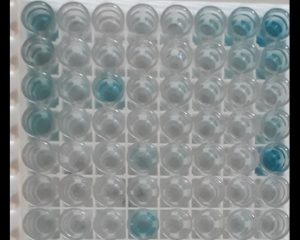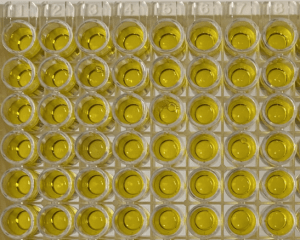No products in the cart.
ELISA Standard Curve Problems and Troubleshooting
ELISA Standard Curve Problems and Troubleshooting correction is essential to achieve reliable results. First of all, ensure that operation tips are done correctly. for example:
- Ensure your samplers are calibrated and working well.
- Your ELISA kit Standards are not expired.
- You add correct volume of standards to ELISA wells.
- Your ELISA method or kit has less than 10% coefficient variation (CV).
- After adding standards, diluents, conjugate and TMB, you mix them well and there are no remaining bubbles inside wells.
- Your ELISA reader is calibrated and works well with less than 5% coefficient variation (CV).
ELISA Standard Curve Problems Troubleshooting
Poor ELISA Standard curve Problems and Troubleshooting
Mostly Poor ELISA Standard Curve with low TMB O.D comes from degradation of coating in ELISA plate. Sometimes it is because of HRP-Conjugate deactivation. After doing coating you need to Block extra sites in ELISA wells. Not only ELISA Blocking Solution will fill empty sites of coated ELISA wells but also it will prepare a long-term stability to your coating. Unstable ELISA coating may result in ELISA Edge Effect or can completely ruins your coating and result in poor standard curve in your test.

Poor ELISA Standard curve
If your coating is degraded , you will see no signal or signal near to your background in all your ELISA wells. Also, It is true, if your HRP-Conjugate Buffer is degraded. But sometime it is because of generation of large aggregated HRP-Conjugates in conjugate buffer. In this case you may have non-orderly ELISA signal.
ELISA Standard Curve Problems Troubleshooting
High signal in ELISA tests Problems and Troubleshooting
High signal in ELISA tests is mostly related to the failure of non- specific binding. Immunoassay tests are based on very specific Ag-Ab reactions. Blocking of nonspecific binding (NSB) in ELISA is a crucial step of designing HRP-Conjugate Stabilizer buffers. In fact, the most important step of blocking NSB is happen by HRP-Conjugate buffer.

High signal in ELISA tests
If the complex of Ag-Ab absorbs to well surface, washing buffer normally will not be able to eliminate them and your test will show very high signal in all of wells, or an unacceptable high ELISA background.
In the indirect ELISA and Immunoassays, failure in blocking Nonspecific binding in ELISA Sample Diluent will have the same results in your ELISA curve. It means that you will see a very high background and high signals in all your ELISA wells.
TMB-Substrate problems and Troubleshooting
Sometimes contamination of ELISA TMB-Solution can result in low or high signal in all ELISA wells. If your ELISA TMB-Substrate is not well stabilized it also can make reaction without HRP by itself that makes high ELISA signal with high background. You can test your ELISA TMB-substrate by making a serial dilution with HRP-conjugate and adding equal volume of it to 100µl of ready-to-use TMB-solution.
ELISA washing problems and Troubleshooting
Usually 3-5X washing with 300 µl ready-to-use ELISA wash buffer is recommended to ELISA wash step. Too stringent washing and incomplete aspiration, Insufficient or not uniform washing can result in a poor ELISA curve. Other reasons such as Incorrect assay temperature, inadequate Incubation times, Enzyme inhibitors such as NaN3, non- optimal Plate reader settings, Cross-Reactivity should be considered in any ELISA tests.



